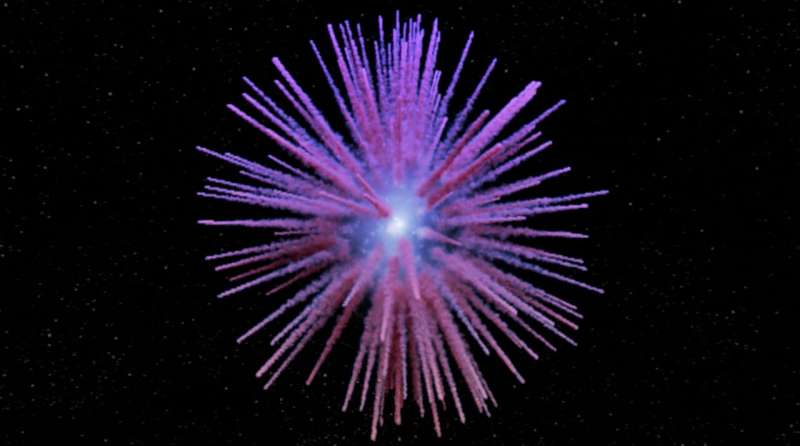
October 24, 2024 by Institute of Science and Technology Austria
Collected at: https://phys.org/news/2024-10-astronomers-dandelion-supernova-zombie-star.html
In 1181, a new star shone near the Cassiopeia constellation for six months before disappearing. This event, recorded as a “guest star” by Chinese and Japanese observers almost a millennium ago, has puzzled astronomers for centuries. It is one of a few supernovae to be documented before the invention of telescopes. In addition, it remained an “orphan” the longest, meaning that none of the celestial objects visible today could be assigned to it.
Now known as the supernova SN 1181, its remnant has only been traced in 2021 to the nebula Pa 30, found in 2013 by amateur astronomer Dana Patchick while examining an archive of images from the WISE telescope as part of a citizen scientist project.
But this nebula is not a typical supernova remnant. In fact, astronomers were intrigued to find a surviving “zombie star” at its center, a remnant within the remnant. The 1181 supernova is thought to have occurred when a thermonuclear explosion was triggered on a dense, dead star called a white dwarf. Typically, the white dwarf would be completely destroyed in this type of explosion, but in this case, some of the star survived, leaving behind a sort of “zombie star.”
This type of partial explosion is called a Type Iax supernova. Even more intriguingly, strange filaments emanated from this zombie star, resembling the petals of a dandelion flower. Now, ISTA Assistant Professor Ilaria Caiazzo and lead author Tim Cunningham, a NASA Hubble Fellow at the Center for Astrophysics, Harvard & Smithsonian, have gotten an unprecedented close-up view of these strange filaments.
Their findings appear in The Astrophysical Journal Letters.
A 3D model of a ballistically expanding explosion
The team around Cunningham and Caiazzo could study this strange supernova remnant in detail thanks to Caltech’s Keck Cosmic Web Imager (KCWI). KCWI is a spectrograph located above 4,000 meters at the W. M. Keck Observatory in Hawaii, near the summit of Mauna Kea volcano, Hawaii’s highest peak.
As its name indicates, KCWI was designed to detect some of the faintest and darkest sources of light in the universe, collectively called the “cosmic web.” In addition, KCWI is so sensitive and smartly designed that it can capture spectral information for every pixel in an image. It can also measure the motion of matter in a stellar explosion, creating something like a 3D movie of a supernova. KCWI does so by examining how the light shifts while moving closer to or away from us, a physical process similar to the familiar Doppler shift we know from blaring sirens that change their tune as an ambulance races by.
Thus, instead of only seeing the typical static image of a fireworks display common to observations of supernovae, the researchers could create a detailed 3D map of the nebula and its strange filaments. In addition, they could show that the material in the filaments traveled ballistically at approximately 1,000 kilometers per second.
“This means that the ejected material has not been slowed down, or sped up, since the explosion,” says Cunningham. “Thus, from the measured velocities, looking back in time allowed us to pinpoint the explosion to almost exactly the year 1181.”
Evidence of an unusual asymmetry
Beyond the dandelion-shaped filaments and their ballistic expansion, the overall shape of the supernova is most unusual. The team could demonstrate that the ejecta—the material within the filaments being ejected away from the explosion site—is unusually asymmetrical. This suggests that the asymmetry stems from the initial explosion itself. Also, the filaments appear to have a sharp inner edge, showing an inner “gap” surrounding the zombie star.
“Our first detailed 3D characterization of the velocity and spatial structure of a supernova remnant tells us a lot about a unique cosmic event that our ancestors observed centuries ago. But it also raises new questions and sets new challenges for astronomers to tackle next,” concludes Caiazzo. She started working on this project as a Burke-Sherman Fairchild Postdoctoral Fellow in theoretical astrophysics at Caltech, U.S., before joining ISTA in May this year.
More information: Tim Cunningham et al, Expansion properties of the young supernova type Iax remnant Pa 30 revealed, The Astrophysical Journal Letters (2024). DOI: 10.3847/2041-8213/ad713b
Journal information: Astrophysical Journal Letters

Leave a Reply